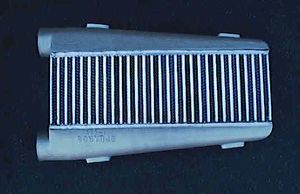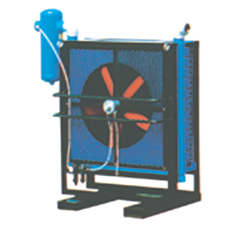Difference between revisions of "Aftercoolers"
| Line 10: | Line 10: | ||
[[File:Water cooled after cooler.jpg|thumb|right|Water cooled after cooler | [[File:Water cooled after cooler.jpg|thumb|right|Water cooled after cooler | ||
]] | ]] | ||
An | An '''Aftercooler''' is any mechanical device used to cool a fluid, including liquids or gasses, between stages of a multi-stage heating process, typically a [[Heat Exchangers]] that removes waste heat in a gas compressor.They are used in many applications, including air compressors, air conditioners, [[Refrigerators]], and gas turbines, and are widely known in automotive use as an [[Air to Air Coolers]] or air-to-liquid cooler for forced induction (turbocharged or supercharged) internal combustion engines to improve their volumetric efficiency by increasing intake air charge density through nearly | ||
isobaric (constant pressure) cooling. | isobaric (constant pressure) cooling. | ||
Aftercoolers increase the efficiency of the induction system by reducing induction air heat created by the turbo charger and promoting more thorough combustion. This removes the heat of compression that occurs in any gas when its pressure is raised or its unit mass per unit volume (density) is increased. A decrease in intake air charge temperature sustains use of a more dense intake charge into the engine, as a result of supercharging.The lowering of the intake charge air temperature also eliminates the danger of pre-detonation of the fuel air charge prior to timed spark ignition. Thus preserving the benefits of more fuel/air burn per engine cycle, increasing the output of the engine. They also eliminate the need for using the wasteful method of lowering intake charge temperature | Aftercoolers increase the efficiency of the induction system by reducing induction air heat created by the turbo charger and promoting more thorough combustion. This removes the heat of compression that occurs in any gas when its pressure is raised or its unit mass per unit volume (density) is increased. A decrease in intake air charge temperature sustains use of a more dense intake charge into the engine, as a result of supercharging.The lowering of the intake charge air temperature also eliminates the danger of pre-detonation of the fuel air charge prior to timed spark ignition. Thus preserving the benefits of more fuel/air burn per engine cycle, increasing the output of the engine. They also eliminate the need for using the wasteful method of lowering intake charge temperature | ||
by the injection of excess fuel into the cylinders' air induction chambers, to cool the intake air charge, prior to its flowing into the cylinders. This wasteful practice nearly eliminated the gain in engine efficiency from supercharging, but was necessitated by the greater need to prevent at all costs the engine damage that pre-detonation engine knocking causes. | by the injection of excess fuel into the cylinders' air induction chambers, to cool the intake air charge, prior to its flowing into the cylinders. This wasteful practice nearly eliminated the gain in engine efficiency from supercharging, but was necessitated by the greater need to prevent at all costs the engine damage that pre-detonation engine knocking causes. | ||
Latest revision as of 08:45, 3 August 2012
An Aftercooler is any mechanical device used to cool a fluid, including liquids or gasses, between stages of a multi-stage heating process, typically a Heat Exchangers that removes waste heat in a gas compressor.They are used in many applications, including air compressors, air conditioners, Refrigerators, and gas turbines, and are widely known in automotive use as an Air to Air Coolers or air-to-liquid cooler for forced induction (turbocharged or supercharged) internal combustion engines to improve their volumetric efficiency by increasing intake air charge density through nearly isobaric (constant pressure) cooling.
Aftercoolers increase the efficiency of the induction system by reducing induction air heat created by the turbo charger and promoting more thorough combustion. This removes the heat of compression that occurs in any gas when its pressure is raised or its unit mass per unit volume (density) is increased. A decrease in intake air charge temperature sustains use of a more dense intake charge into the engine, as a result of supercharging.The lowering of the intake charge air temperature also eliminates the danger of pre-detonation of the fuel air charge prior to timed spark ignition. Thus preserving the benefits of more fuel/air burn per engine cycle, increasing the output of the engine. They also eliminate the need for using the wasteful method of lowering intake charge temperature by the injection of excess fuel into the cylinders' air induction chambers, to cool the intake air charge, prior to its flowing into the cylinders. This wasteful practice nearly eliminated the gain in engine efficiency from supercharging, but was necessitated by the greater need to prevent at all costs the engine damage that pre-detonation engine knocking causes.

